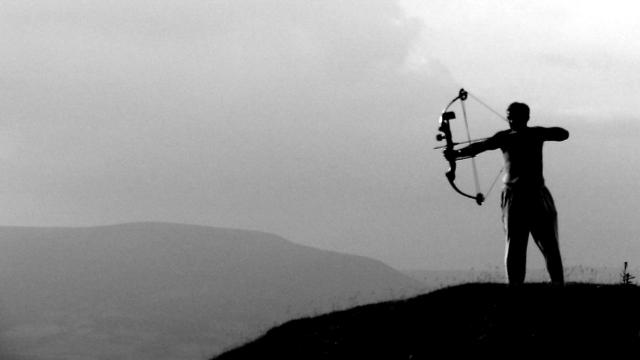The fastest, most powerful, most accurate bows ever made are modern compound designs. What advantages do they have over traditional bows of yore and how do you shoot one?
This year, I’ve learned the sport of archery. Starting out, I hadn’t shot a bow since Boy Scouts, but now, I can accurately hit a two-inch circle multiple times out to 55 metres or more. This article will be a distillation of what I’ve learned getting there and an introduction to the sport and the technology for people not familiar with it. Forgive me if I simplify some points with the goal of brevity and readability.
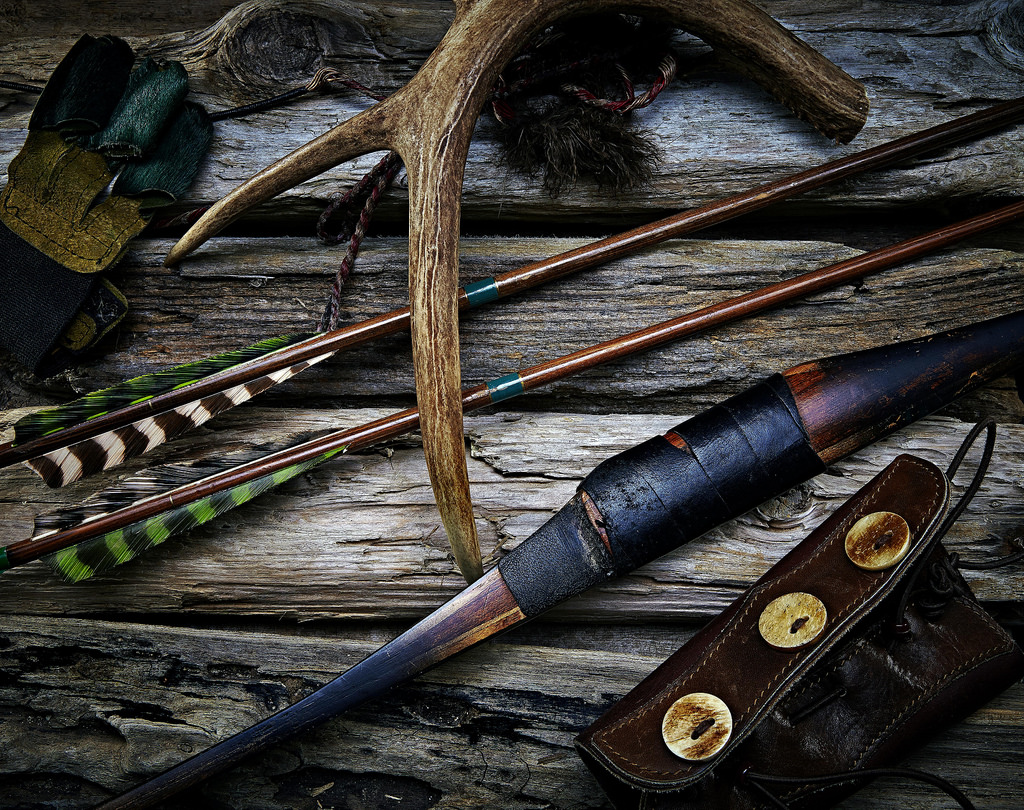
Traditional bows can be beautiful works of art and are a lot of fun to shoot. But their objective inferiority to modern materials and engineering cannot be argued. Photo: Jim Wrigley.
The Difference Between Compound And Traditional Bows
All bows use the mechanical advantage of leverage to store energy in flexed limbs as you draw them. This is how they shoot an arrow faster than you could throw one.
In a traditional bow — longbow, recurve, whatever — store this energy directly. The further you draw them, the harder they get to pull and the more energy is transferred into the arrow when you release. The more effort it takes to draw a traditional bow, the faster it will shoot an arrow. When you’ve drawn a traditional bow all the way to your ear, you’re left holding the entirety of it’s draw weight. So if your bow draws 32kg, you’re holding 32kg between your hands. Which is hard.
The big wheels on the ends of a compound bow are cams and their profile is designed to create a “let off” at the end of the draw. Typically this is between 60 and 80 per cent of the draw weight. So with my bow — a PSE Full Throttle — I have a 70 percent let off, meaning that with its 32kg draw weight, I only have to hold 22kg. That allows me to hold it at full draw for longer, using that time to take more careful aim on the range or to wait for the animal to move into a perfect shot while hunting. Less effort also means I’m able to hold the bow steadier, further increasing accuracy.
Through the profile of those cams, bow designers are also able to determine how much of the bow’s power is applied to the arrow at what point in the string’s travel. The Full Throttle is so fast because it’s able to get full power to the arrow very early in its travel, then hold it there until it leaves the string.
At 112 metres per second, its IBO speed — an standardised measure of the speed at which a bow shoots its arrow — the Full Throttle is the fastest shooting production bow ever made. A very fast traditional bow is lucky to reach 55 metres per second.
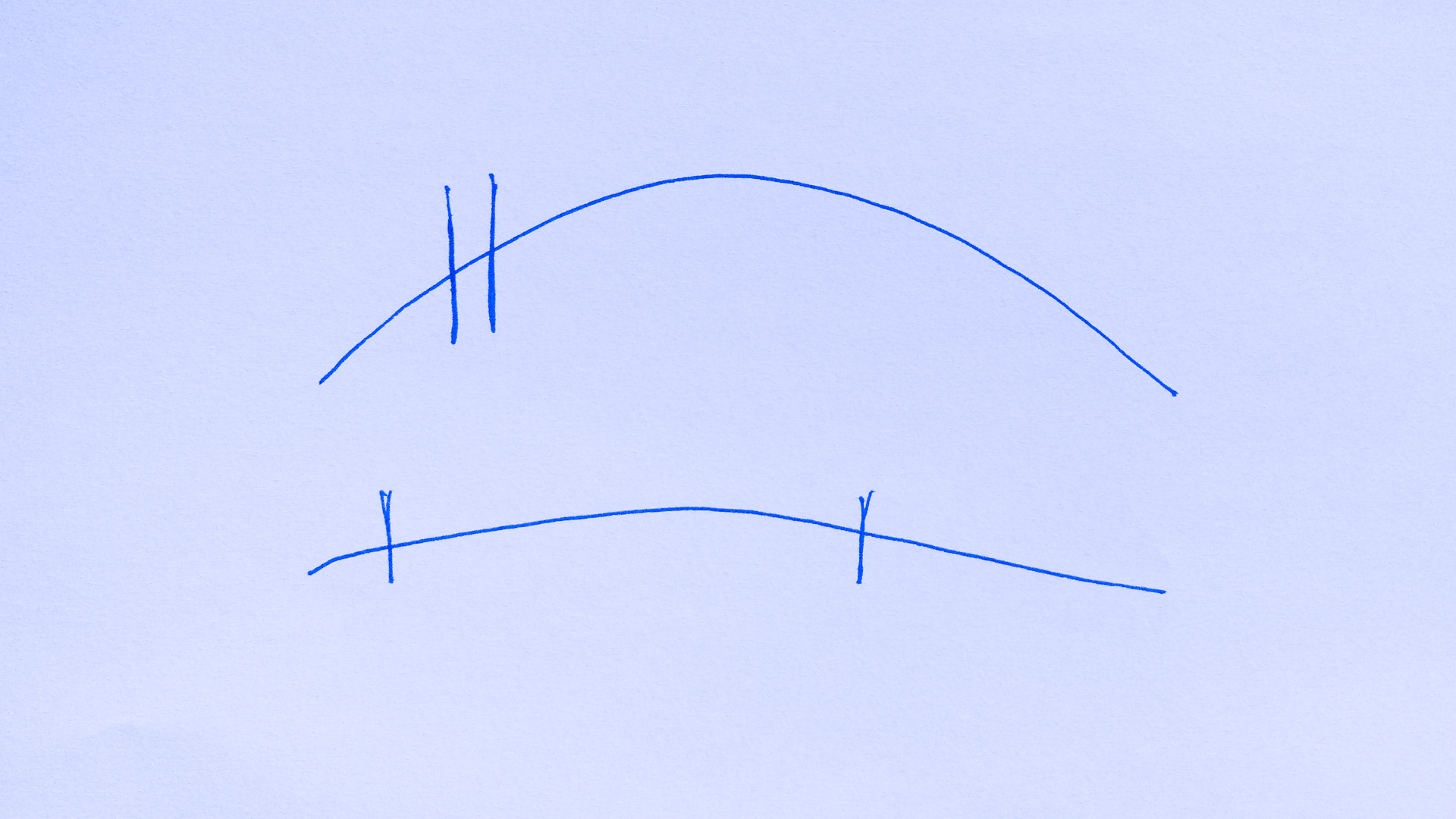
My extremely poor, extremely exaggerated sketch demonstrating the arc of a fast bow versus that of a slow one. By shooting a flatter arc, the faster bow is able to stay “on target” through more of its range. This is relative accuracy.
Why Speed Matters
Given an equal weight and other characteristics, a faster arrow is a more powerful arrow. This not only means it can hit its target with more force (good for hunting), but that it flies through a flatter arc over a given distance. This increases the relative accuracy of the bow.
Relative accuracy is the distance through which an arrow will impact pretty much the same point on a target. So, with a flatter travelling arrow, you have a longer distance of relative accuracy. This is important because estimating the range of a target is one of the fundamental challenges of archery. A flatter shooting arc is more forgiving of mistakes in the estimation of that range.
With my bow, for instance, the 18 metre pin (more on sights later) will result in a close-enough hit anywhere from 9 to 27 metres. Hell, it will only be two inches low at 36 metres.
This is doubly important as you move into the field and start shooting up or down hill. And believe me, once you starting bringing angle calculations into your sporting life, the real world becomes surprisingly hilly. The ability to deal with them is one of the biggest advantage a compound bow delivers.
I was surprised to learn that outright distance isn’t really a big advantage for compounds. Due to wind and elevation and numerous other factors like those, the vast majority of bow hunters operate within a 90 metre range. And any quality bow will work within that distance.
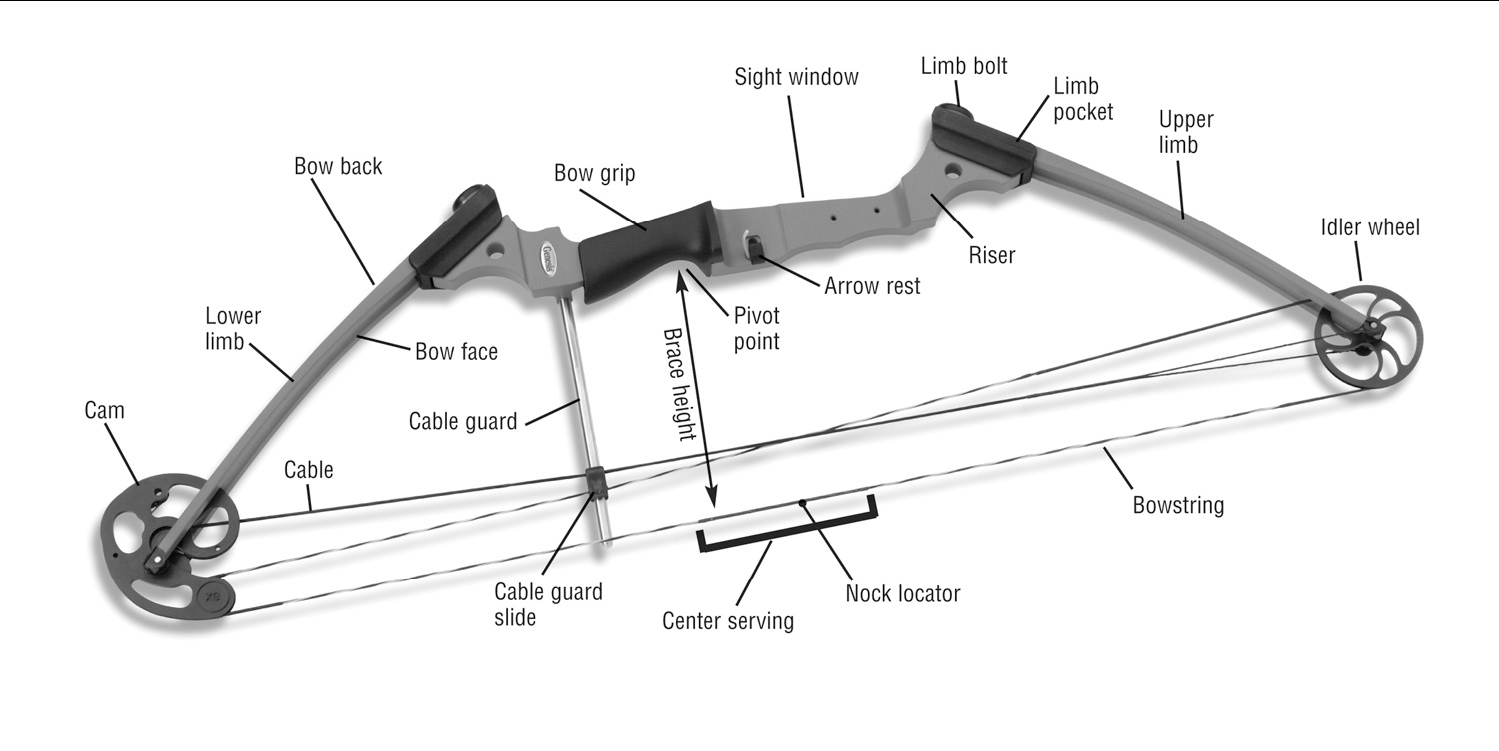
Compound Bow Parts
Riser: The bow’s “chassis.” Holds the limbs and provides a place for a handle and mounts stuff like the arrow rest, stabilizer, sight etc. Needs to be light and strong and shouldn’t flex at all.
Limbs: The parts that flex, storing and releasing energy.
Cams: You can have one cam (in which case there’s an idler wheel on the other side, it just spins without doing anything), two cams or hybrid cams. Single cams are easy to pull and easy to adjust, but not that fast. Two cams are harder to pull and harder to synchronise, but are as fast as possible. A hybrid cam give you the power of two with the ease of adjustment of one.
Bowstring: You pull on it to rotate the cams, flex the limbs and, when you release, it launches the arrow. Modern bow strings are made from space age materials that won’t stretch.
Cables: These lash the limbs to the cams, enabling the latter to pull on the former.
Cable Slide: Holds the cables off to one side, away from the path of the arrow.
Brace Height: The distance between the “throat” of the grip and the string, at rest. The shorter this distance is, the longer the distance the string remains in contact with the arrow. The shorter the brace height, the longer the string applies power to the arrow, which is crucial for faster speeds. But, the longer the string remains in contact with the arrow, the longer movement from the shooter can be transferred to its flight, so shorter brace heights are less forgiving of shooter error.
Necessary Compound Bow Accessories
These don’t come included when you buy most bows as they’re the subject of much preference between archers; we all have our own likes and dislikes depending on shooting style, conditions and disciplines.

Arrow Rest: This is what the arrow “rests” on as the bow is drawn, held and fired. These come in numerous different designs; all a slight tweak on the theme of not getting in the way of the arrow’s fletchings. Hunters require a “full capture” design that surrounds the arrow completely, so it can’t fall off as you move through the bush. Target rests are more dainty, designed for minimal contact.
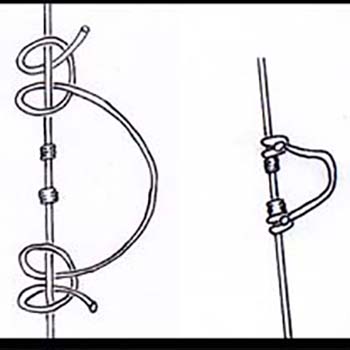
D-Loop: A tiny loop of cord attached to the string’s serving. You knock the arrow between its attachments and clip onto the loop with your release to draw it.
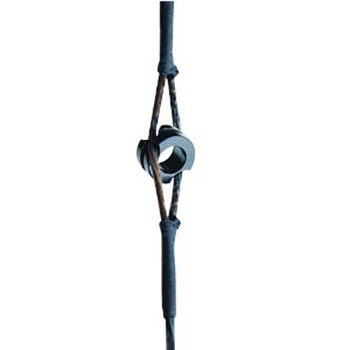
Peep: A small metal or plastic circle installed in the bow string, it acts as the rear sight, allowing you to properly align with the bow sight.
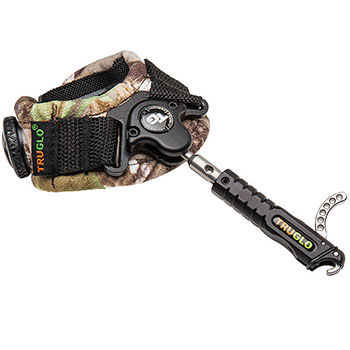
Release: You don’t draw a compound with your fingers. Instead, a mechanical release wraps your wrist tightly, transferring weight directly to your arm and thereby augmenting the poundage you’re able to pull. These come as either two-sided pincers or one-sided hooks; both are operated by a trigger you operate with either your point pointer or middle finger. Such an arrangement facilitates a cleaner release of the string than you could achieve with your fingers, further boosting accuracy. I strongly prefer a one-sided release as it can be connected to the D-loop without looking down and with less fiddling.
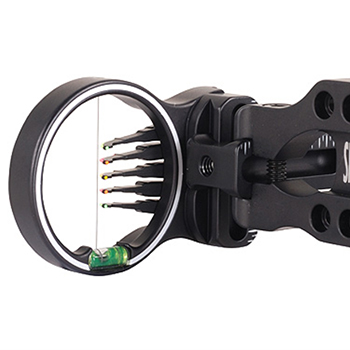
Sight: Gathering ambient light and transferring it to the top of the pins via fibre optic cables, you align each of the pins with a known distance on the range. Then, in the field, you estimate the range to a target and align it with or between the appropriate pin(s). Sights may also be adjustable, allowing you to dial in the range a pin points to as necessary. Fixed pin sights are quicker to use in action, adjustable sights may allow a greater degree of accuracy. I have a five-pin sight set to 20, 30, 40, 50 and 60 yards. Due to the incredible relative accuracy of the Full Throttle, I plan to visit the range next weekend and change that to 20, 40, 60, 80 and 100. The distance between the peep and the sight allows you to align everything properly.
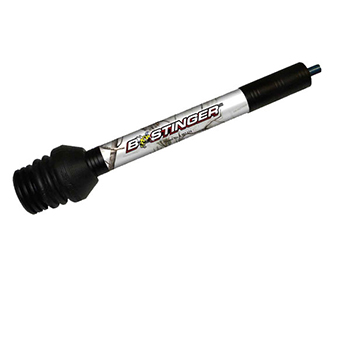
Stabilizer(s): These help balance the bow in your hand for more stability and a cleaner follow through, while also cutting down on vibrations as you shoot. Target archers use one very long stabilizer for max stability and some even use secondary stabilizers that point back and to the sides. Hunters need a more compact form factor for moving and carrying, so stick with one short, but weighty stabilizer mounted to the front of the bow, below the grip. Dial in the weight and length to your preference, after you’ve fitted the other accessories.
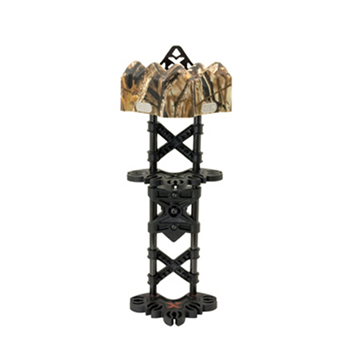
Quiver: Mounts to the side of the bow and holds your arrows. In it’s top sheath, razor sharp broadheads are fully contained in foam. Old school back and hip quivers are slower to reach and more likely to catch on stuff as you move in the field. You’ll see target archers still carry hip quivers, but hunters pretty much only use bow-mounted quivers in order to facilitate movement and to better guard those dangerous, fragile broadheads.
There’s more components of a bow and bow accessories, but these are the ones you need to know about.
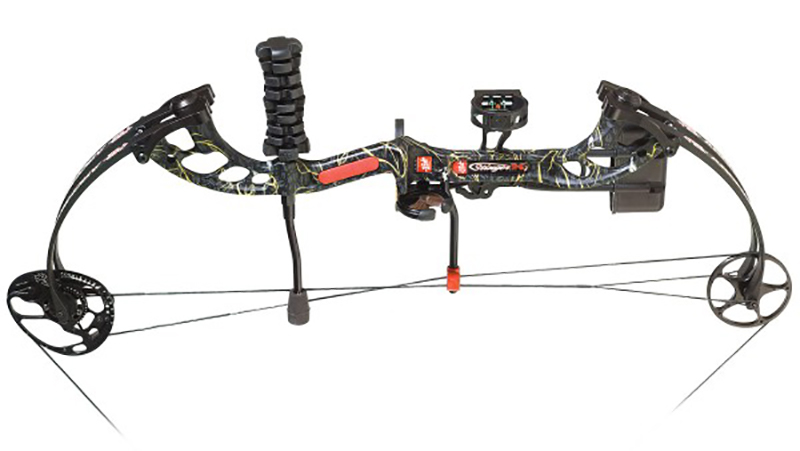
“Field Ready” bows like this PSE Stinger come with all the accessories you need to shoot. They tend to be decent bows with serviceable accessories that you’ll probably want to upgrade over time.
Which Bow Is Right For You?
There’s a whole bunch of bows out there and as with most products, their merits are obfuscated by various whackadoo marketing claims and masked with jargon. Luckily, cutting through all that and finding a good bow that works for you is easy.
First, give yourself a total budget. This will need to include the bow, the accessories and the arrows. Expect to spend at least $110 for a dozen arrows cut to length and fitted with field tips for the range. Your local pro shop will handle that.
You can find decent “Field Ready” bows (already fitted with accessories) starting at about $800. These are plenty for getting started, lasting a couple seasons and taking your first deer or two. As with all things, I went overboard, got an expensive bow and fitted it with the best accessories possible, along with expensive arrows. The Full Throttle retails for $1,400 and I easily matched that with all the other stuff it needed before I could take it hunting. That was overkill, you shouldn’t need to spend more than $1,400-$1,700 total to get nice stuff that will work for a long time.
Once you know how much you want to spend, visit your local pro shop/range, give them that number and ask to try bows that fit it. The best bow for you is the one that feels best in your hands. The pro shop will be able to determine your draw length (many bows must be ordered with a set length, others need to be adjusted to it) and advise on what weight you should draw. Don’t try to be macho and chose too heavy a draw, doing so will ruin your shooting and even a 18kg bow can take a buck. If you’re not that strong, look for a bow with as much let off as possible.
I did all this at Los Angeles’s Oak Tree Gun Club. Carlos, the pro there, is the Southwest sectional champion, so knows what he’s talking about, and is a friendly guy to boot. Jason, his assistant, is nearly as knowledgable and spent an absolute ton of time with me as I learned. Both were exceptionally patient. If you live in SoCal, you’ll be in good hands there.
The pro shop will get you fitted up with arrows of an appropriate spine (flex) for your bow, cut them to size, help you determine which accessories are right for you, then get them all fitted. If you buy everything from them, you shouldn’t expect to pay for labour.
Archery is a great sport for kids too, especially with its presence in movies and on TV right now. This is my buddy Karma, I’m helping her learn.
Starting To Shoot
The first thing you’ll need to do with your bow is shoot it in, which gets any stretch out of the brand new string. Put about 150 arrows down range to do that. Then, you can have your peep installed and begin to align your sight.
Every sight is going to work a little differently, but here’s some general advice. Have your pro approximate the 18 metre pin, then shoot it at that range in groups of six arrows, tweaking the sight’s main adjusters to follow the pattern of the arrows. If your group is low and to the left, adjust the pin downwards and to the left. Once you have a solid grouping for that 20 pin, starting shooting on down through the others, using the fine adjusters to tweak them slightly in the same way, but leaving the big adjustments alone. If you’re new, expect do devote several solid visits to the range to achieve this.
At the same time that you’re sighting in, you’ll need to be practicing form and follow through. The pro can help you here. The main points are to stand with your feet aligned perpendicular to the target (the front toe can point forwards a bit) and shoulder width apart. Do not fully extend your bow arm, keep some flex in it. And don’t tightly grip the bow. Draw the bow with your elbow high, hand flat and relaxed. Find consistent anchor points on your face for the string and trigger the release smoothly. Hold the bow completely still as you watch the arrow travel downrange and impact the target; that’s the follow through that’s so crucial to accuracy.
Once you’ve got your sights aligned and are confident on the range, you’ll want to head to the 3D course which approximates real world targets, obstacles and elevations. 3D is a sport all its own, where guessing the range is one of the crucial components, but if you’re just learning to shoot, drag along a range finder and make your life easy as you adapt to stuff like shadows and small targets. And plan to lose a few arrows.
When you’re confident on 3D, have put the range finder away and are consistently on target, then and only then are you ready to head into the field.
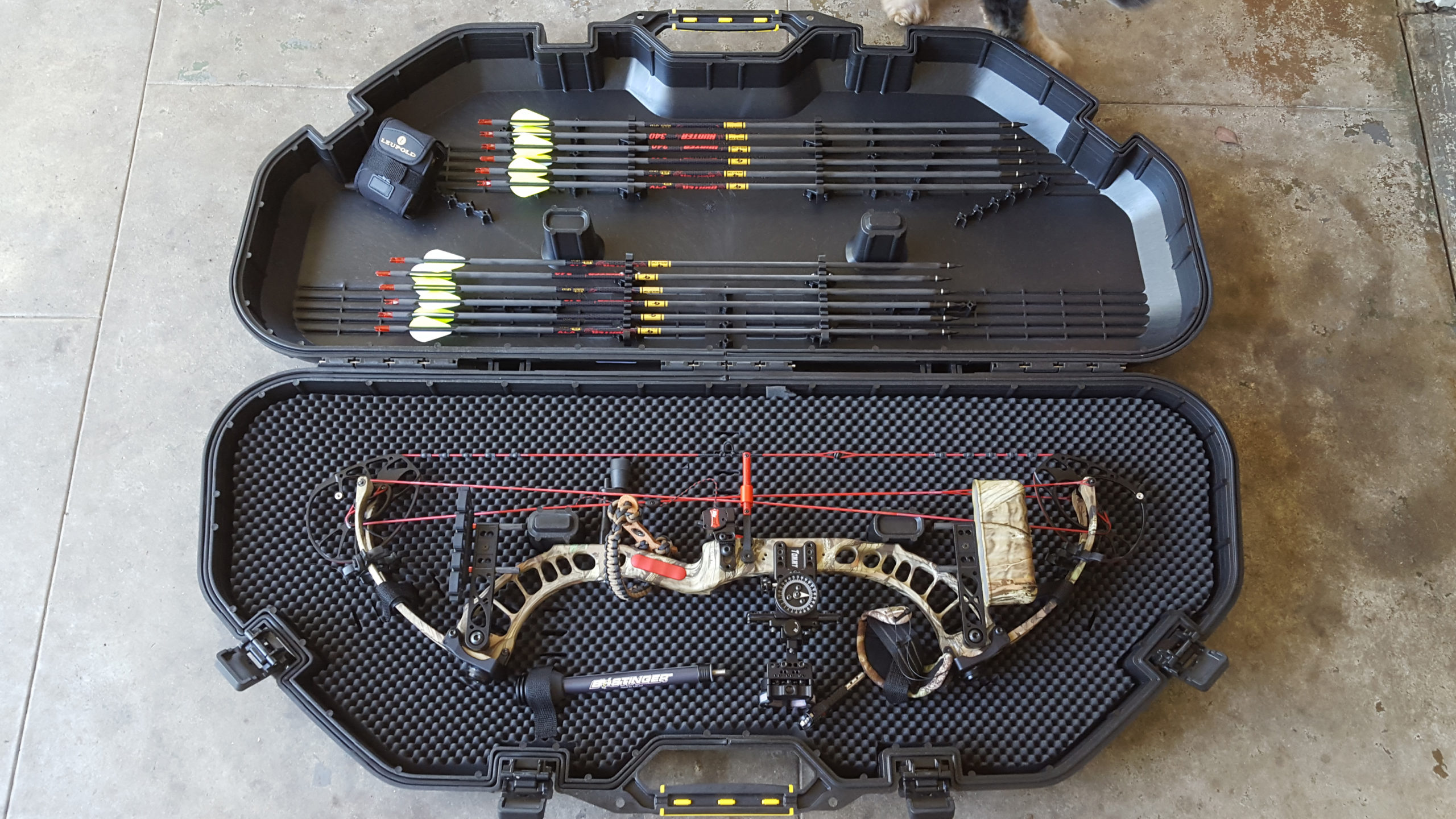
My setup. I’ve since upgraded to fancier arrows. You pay more for more consistent straightness.
Tips And Tricks
Want to work on strength for archery? An overall weightlifting program will be a big help, but a good way to expressly address your ability to draw and hold a heavy bow is with the appropriately named “Archer Rows.” Using a dumbbell and a bench, brace one hand against the bench as you lay against it with your feet shoulder width apart and your core braced. Pull the dumbbell off the ground and up into your armpit as you hold your torso steady. You’ll note that this motion approximates the two handed brace and pull of drawing a bow. Do it for both arms, which also helps even out any muscle imbalance shooting might create.
A good range finder is an invaluable tool both as you learn to estimate ranges and as a neophyte shooter progresses to the field. Look for one that automatically compensates for elevation, simply kicking you the number to aim for. I use a Leupold RX1200i TBR, which can do that for both bow and any popular rifle load.
You’ll want a good case for storing your bow safely and securely at home and transporting it to the range and field. This Plano is surprisingly robust.
If you’re just thinking about picking this up, you may not know this: never “dry fire” a bow. Without the weight of the arrow to push, the force of the string can literally cause them to explode. Be as careful handling a bow as you would a firearm and never allow anyone to handle yours if they don’t know what they’re doing.
You’ll need to re-adjust your sights when you make the switch to broadheads for field work. Oak Tree found an old 3D target and allowed me to do this on their range, but you may be stuck doing it in your yard or on the evening before a hunt. Allow time to do it, bring your range finder to assist and bring an appropriate target to shoot into. Missing that will ruin your broadhead!
I was surprised by how big a help a sight light provided as I practiced into evenings. But one may not be legal to hunt with in your state. Consult your pro shop to find out and make sure your remove it before you head into the field if it’s not legal.
Top photo: Samzie
.
